Posted on August 31, 2023 by Natalie Houghtalen and Makennah Troy
The data is in…nuclear energy is far more popular than you may have guessed. One of the largest research projects around nuclear energy sentiment conducted in recent history confirms this, but the U.S. Congress has also taken significant, bipartisan steps showing the growing support for more nuclear energy. In July, the U.S. Senate voted 96-3 on a provision that would strengthen U.S. global leadership in nuclear energy by improving the fuel supply chain.
The Potential Energy Coalition, a nonprofit focused on low-cost decarbonization pathways, surveyed 13,500 people from eight countries and discovered immense global nuclear energy support.
Building new nuclear is an integral part of meeting the U.S. climate goals. Nuclear energy is low-carbon, and reliable – able to run 24/7. New nuclear technologies, often referred to as advanced nuclear, bring additional advantages such as improved safety conditions, far-reaching distribution, and the ability to reduce emissions in non-electric sectors like refining or heavy manufacturing. The U.S. should leverage more nuclear energy, not only in response to the climate, but also for its economic advantages, and this research is a good sign there is plenty of support for this effort. ClearPath has five key takeaways from the global research.
Nuclear power is more popular than most people have been led to believe. For decades nuclear power has been cast as divisive – even recently a 2023 Gallup Poll and a 2021 Pew Research Study found that Americans are split on nuclear energy with 50-55% in favor of new nuclear. However, studies of this nature downplay the public’s support for nuclear power. They typically only include a small sample group of about 1000 people and do not address those who may lean one way or another towards accepting or opposing nuclear energy, but are reportedly undecided.
Potential Energy took a bigger approach. They surveyed over 2,000 Americans and a total of 13,500 people globally including South Korea, Japan, France, Germany, the United Kingdom, Poland, and Sweden. When asked a yes or no question about whether advanced nuclear energy should be part of the U.S.’ energy future, over 76% of Americans were supportive, an encouraging sign for U.S. policymakers advancing nuclear energy policy and for future nuclear energy bills.
Between the eight countries, on average nearly 64% of people clearly support advanced nuclear; although, the average percentage of people in support of advanced nuclear power skyrockets to 79% when people are presented with only yes or no options. Even in countries where anti-nuclear policies were implemented in recent years, such as Germany and Japan, 72% and 65% of the populations, respectively, favor nuclear energy. As support for nuclear energy increases, governments should cooperate to deploy dispatchable and reliable nuclear energy.
Nuclear Support by Country
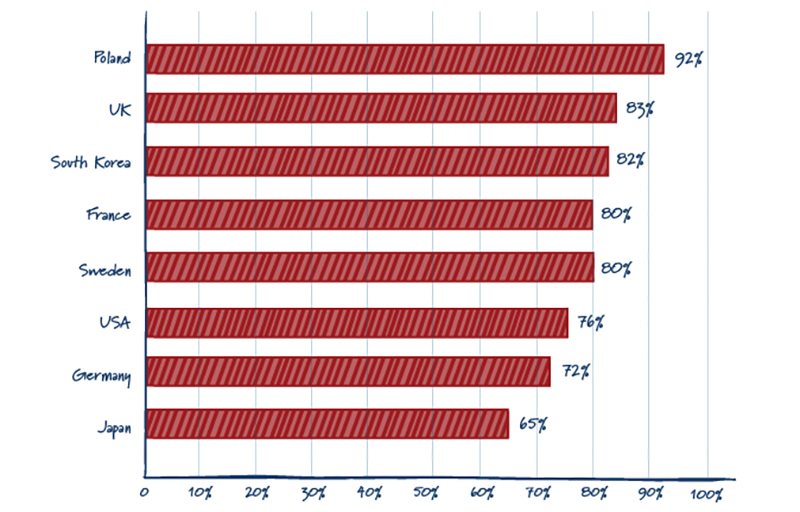
Source: The World Wants New Nuclear, Figure 4
Gen Z and Millennials have grown up with a constant barrage of climate news. Combine that with the climate impacts in the U.S. and around the world, you can understand why younger generations are less likely to oppose nuclear energy. They view both climate action and energy independence as extremely important, and are more flexible on taking an all-of-the-above approach to clean energy solutions. As noted in the chart below, ages 18-54 hold less strong opinions on nuclear energy than ages 55 and above.
Generational Nuclear Support Trends
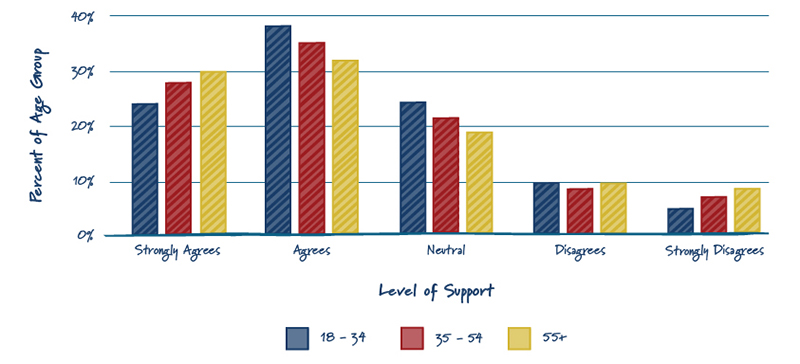
Source: The World Wants New Nuclear, adapted from Figure 7
People of all backgrounds support nuclear energy. Combining income, education, and occupational demographic factors, Potential Energy split its participants into four groups:
1. Pro-Growth Established (28% of the sample)
2. Concerned Professionals (27% of the sample)
3. Hard Working Pragmatists (30% of the sample)
4. Determined Skeptics (15% of the sample)
Except for the Determined Skeptics, barely 1/7 of each of these groups oppose nuclear power. Many people recognize the importance of nuclear power. When provided information about nuclear energy’s potential in accelerating clean innovation, maintaining energy independence, optimizing land-use, boosting the economy, and meeting climate goals, 70% of each country’s population viewed nuclear energy more favorably. This is a good reminder for nuclear advocates to highlight nuclear energy advancements and nuclear energy policy that benefit the public.
Support for New Nuclear

Source: The World Wants New Nuclear, adapted from Figure 19
In the U.S. at least 60% of voters in each major party support nuclear energy. However, this trend is not unique to the U.S.. The average support mirrors these trends and is similarly nonpartisan throughout all of the countries surveyed.
Because nuclear power is accepted regardless of political stances, it should be treated in a non-partisan and non-regional manner. Recent examples in the U.S. Congress include the 96-3 and 86-11 Senate votes to amend the Nuclear Fuel Security Act and the Accelerating Deployment of Versatile Advanced Nuclear for Clean Energy (ADVANCE) Act to the National Defense Authorization Act respectively.
Global Average Political Party Support for New Nuclear
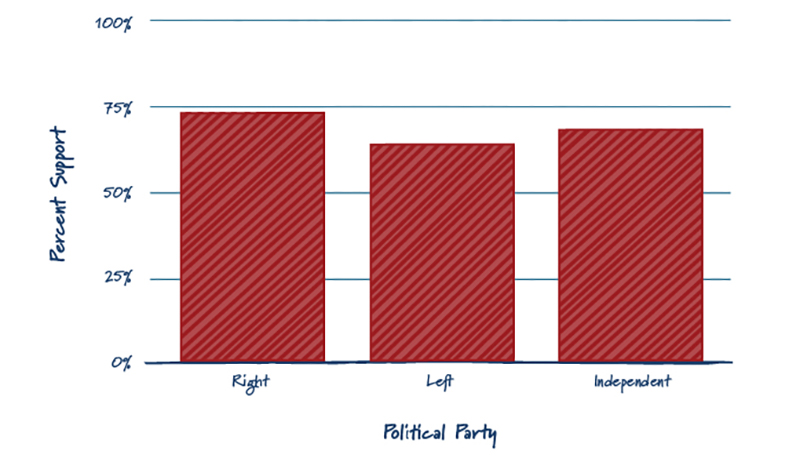
The World Wants New Nuclear, adapted from Figure 10
*Right parties include the U.S. republican party, the European Conservative and Reformists Party, and other national right leaning political groups.
Left parties include the Confederal Group of the European United Left, the Socialists and Democrats Party, Democrat parties, and Communist Parties.
Independent parties include those classified as “independent” by individual countries, the Renew Europe party, and the Green parties.
Advanced nuclear support increases with education, but in order for public support to increase, information surrounding advanced nuclear must be presented in a way that is accessible and understandable.
When the nuclear industry uses less jargon, people’s acceptance of new nuclear innovations improve. Although nuclear energy technology sounds complicated, the terms used publicly to discuss it do not have to be. Instead, people prefer relatable names for advanced nuclear technologies like “New Nuclear” or “Clean Fission.”
World Support for Advanced Nuclear Technology Names
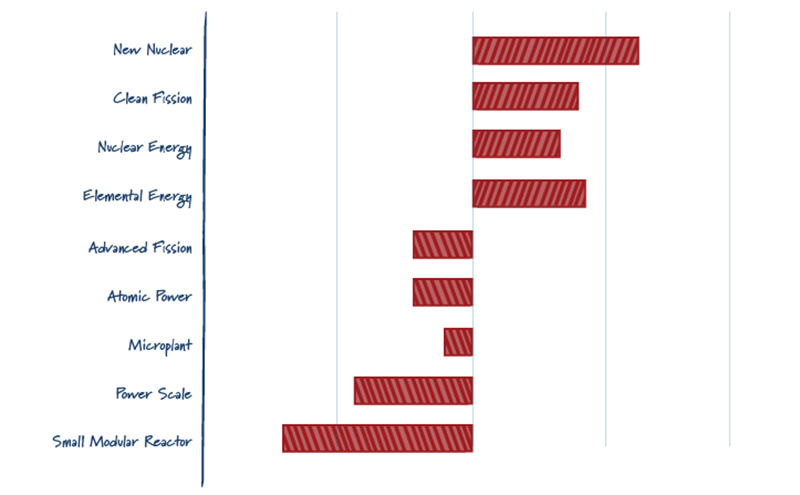
Source: The World Wants New Nuclear, adapted from Figure 20
People trust and want to hear from nuclear experts. These stakeholders should publicly discuss exciting policies, initiatives, and innovative advancements to gain the public’s support.
Preferred Messengers (% Selected)
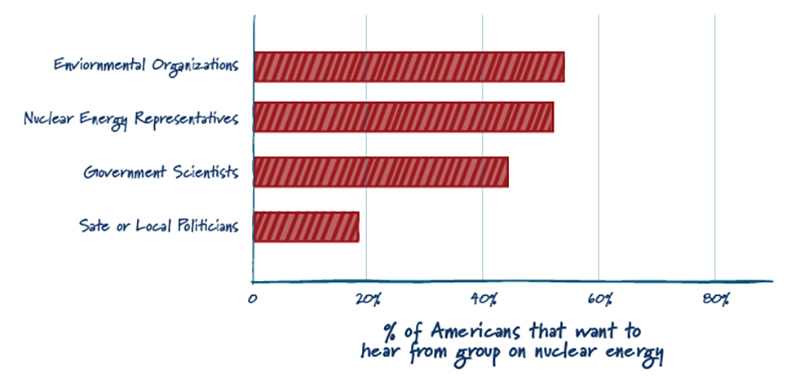
Source: The World Wants New Nuclear, adapted from Figure 22
Conscious branding of nuclear energy with non-technical terms such as “new nuclear” is essential, especially as Congress enacts more pro-nuclear energy policies. Recent nuclear energy policies include the Nuclear Energy Leadership Act and the Nuclear Energy Research and Development Act, which were both enacted in the bipartisan Energy Act of 2020. On top of that, more recently introduced legislation, like the International Nuclear Energy Act, Nuclear Fuel Security Act and the ADVANCE Act, are going to require industry backing from the preferred messengers to maintain high levels of public support – levels over the 76% of the United States, which is already willing to support nuclear energy.
Nuclear energy policy advocates must connect to benefits in energy independence, clean innovation, climate goals, and economic growth to continue to increase the favorability of new nuclear for the whole of the American public.
A majority of the world is already on board with nuclear, but continued support is never guaranteed.
Experts from environmental organizations, the nuclear industry, and research institutions must explain the advantages of new nuclear to expand this support. Potential Energy’s report is a tool for predicting how the broader public will respond to nuclear energy policy and industry advancements: positively.
As new nuclear energy already has broad support not only within the U.S., but internationally, policymakers can employ this approval to help progress nuclear policies which enhance the U.S.’ position as a leader in clean energy.
The world wants new nuclear, the United States can help provide it.
